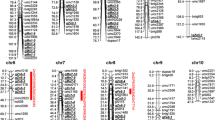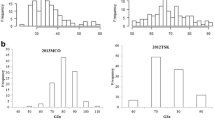Abstract
Key message
Understanding the correlations of seven minerals for concentration, content and yield in maize grain, and exploring their genetic basis will help breeders to develop high grain quality maize.
Abstract
Biofortification by enhanced mineral accumulation in grain through genetic improvement is an efficient way to solve global nutrient malnutrition, in which one key step is to detect the underlying quantitative trait loci (QTL). Herein, a maize recombinant inbred population (RIL) was field grown to maturity across four environments (two locations × two years). Phenotypic data for grain mineral concentration, content and yield were determined for copper (Cu), iron (Fe), manganese (Mn), zinc (Zn), magnesium (Mg), potassium (K) and phosphorus (P). Significant effects of genotype, location and year were observed for all investigated traits. The strongest location effects were found for Zn accumulation traits probably due to distinct soil Zn availabilities across locations. Heritability (H 2) of different traits varied with higher H 2 (72–85 %) for mineral concentration and content, and lower (48–63 %) for mineral yield. Significant positive correlations for grain concentration were revealed between several minerals. QTL analysis revealed 28, 25, and 12 QTL for mineral concentration, content and yield, respectively; and identified 8 stable QTL across at least two environments. All these QTL were assigned into 12 distinct QTL clusters. A cluster at chromosome Bin 6.07/6.08 contained 6 QTL for kernel weight, mineral concentration (Mg) and content (Zn, K, Mg, P). Another cluster at Bin 4.05/4.06 contained a stable QTL for Mn concentration, which were previously identified in other maize and rice RIL populations. These results highlighted the phenotypic and genetic performance of grain mineral accumulation, and revealed two promising chromosomal regions for genetic improvement of grain biofortification in maize.

Similar content being viewed by others
References
Abiola O, Angel JM, Avner P, Bachmanov AA, Belknap JK et al (2003) The nature and identification of quantitative trait loci: a community’s view. Nat Rev Genet 4:911–916
Anandan A, Rajiv G, Eswaran R, Prakash M (2011) Genotypic variation and relationships between quality traits and trace elements in traditional and improved rice (Oryza sativa L.) genotypes. J Food Sci 76:122–130
Antunović M, Kovačević V, Rastija M, Zdunić Z (2003) Influences of soil and genotypes on micronutrient status in maize plants. Agriculture 9:9–14
Baxter IR (2009) Ionomics: studying the social network of mineral nutrients. CurrOpin Plant Biol 12:381–386
Baxter I, Dilkes BP (2012) Elemental profiles reflect plant adaptations to the environment. Science 336:1661–1663
Baxter IR, Hermans C, Lahner B, Yakubova E, Tikhonova M et al (2012) Biodiversity of mineral nutrient and trace element accumulation in Arabidopsis thaliana. PLoS One 7:e35121
Baxter IR, Gustin JL, Settles AM, Hoekenga OA (2013) Ionomic characterization of maize kernels in the intermated B73 × Mo17 population. Crop Sci 53:208–220
Baxter IR, Ziegler G, Lahner B, Mickelbart MV, Foley R et al (2014) Single-kernel ionomic profiles are highly heritable indicators of genetic and environmental influences on elemental accumulation in maize grain (Zea may). PLoS One 9:e87628
Bouis HE, Welch RM (2010) Biofortification—a sustainable agricultural strategy for reducing micronutrient malnutrition in the global south. Crop Sci 50:S20–S32
Bremner JM (1996) Nitrogen-total. In: Sparks DL (ed) Methods of soil analysis. Part 3. Chemical methods. SSSA Book Ser. 5. SSSA and ASA, Madison, pp 1085–1121
Buescher E, Achberger T, Amusan I, Giannini A, Ochsenfeld C et al (2010) Natural genetic variation in selected populations of Arabidopsis thaliana is associated with ionomic differences. PLoS One 5:e11081
Cakmak I (2002) Plant nutrition research: priorities to meet human needs for food in sustainable ways. Plant Soil 247:3–24
Cakmak I, Pfeiffer WH, Mcclafferty B (2010) Biofortification of durum wheat with zinc and iron. Cereal Chem 87:10–20
Chahal DS, Sharma BD, Singh PK (2005) Distribution of forms of zinc and their association with soil properties and uptake in different soil orders in semi-arid soils of Punjab, India. Commun Soil Sci Plant Anal 36:2857–2874
Churchill GA, Doerge RW (1994) Empirical threshold values for quantitative trait mapping. Genetics 138:963–971
Fan MS, Zhao FJ, Fairweather-Taitc SJ et al (2008) Evidence of decreasing mineral density in wheat grain over the last 160 years. J Trace Elem Med Biol 22:315–324
Garcia-Oliveira AL, Tan LB, Fu YC, Sun CQ (2009) Genetic identification of quantitative trait loci for contents of mineral nutrients in rice grain. J Integr Plant Biol 51:84–92
Goto F, Yoshihara T, Toki S, Shigemoto N, Takaiwa F (1999) Iron fortification of rice seed by the soybean ferritin gene. Nat Biotech 17:282–286
Gregorio GB, Senadhira D, Htut H, Graham RD (2000) Breeding for trace mineral density in rice. Food Nutr Bull 21:382–386
House WA (1999) Trace element bioavailability as exampled by iron and zinc. Field Crops Res 60:115–141
Imtiaz M, Alloway BJ, Shah KH, Siddiqui SH, Memon MY, Aslam M, Khan P (2003) Zinc nutrition of wheat: growth and zinc uptake. Asian J Plant Sci 2:152–155
Kumar R, Bohra JS (2014) Effect of NPKS and Zn application on growth, yield, economics and quality of baby corn. Arch Agron Soil Sci 60:1193–1206
Kumar R, Mehrotra NK, Nautiyal BD, Kumar P, Singh PK (2009) Effect of copper on growth, yield and concentration of Fe, Mn, Zn and Cu in wheat plants (Triticum aestivum L.). J Environ Biol 30:485–488
Lindsay WL, Norvell WA (1978) Development of a DTPA soil test for zinc, iron, manganese and copper. Soil Sci Soc Am J 42:421–428
Liu J, Cai H, Chu Q, Chen X, Chen F, Yuan L, Mi G, Zhang F (2011) Genetic analysis of vertical root pulling resistance (VRPR) in maize using two genetic populations. Mol Breeding 28:463–474
Lung’aho MG, Mwaniki AM, Szalma SJ, Hart JJ, Rutzke MA, Kochian LV, Glahn RP, Hoekenga OA (2011) Genetic and physiological analysis of iron biofortification in maize kernels. PLoS One 6:e20429
Mayer JE, Pfeiffer WH, Bouis P (2008) Biofortified crops to alleviate micronutrient malnutrition. Curr Opin Plant Biol 11:166–170
McDowell SC, Akmakjian G, Sladek C, Mendoza-Cozatl D, Morrissey JB et al (2013) Elemental concentrations in the seed of mutants and natural variants of Arabidopsis thaliana grown under varying soil conditions. PLoS One 8:e63014
Nyquist WE (1991) Estimation of heritability and prediction of selection response in plant populations. Crit Rev Plant Sci 10:235–322
Olsen SR, Cole CV, Watanabe FS, Dean LA (1954) Estimation of available phosphorus in soils by extraction with sodium bicarbonate. Circular 939, United States Department of Agriculture, Washington
Pacini C, Wossink A, Giesen G, Vazzana C, Huirne R (2003) Evaluation of sustainability of organic, integrated and conventional faming systems: a farm and field-scale analysis. Agric Ecosys Environ 95:273–288
Pfeiffer WH, McClafferty B (2007) HarvestPlus: breeding crops for better nutrition. Crop Sci 47:S88–105
Philip JW, Martin RB (2005) Biofortifying crops with essential mineral elements. Trends Plant Sci 10:586–593
Pillen K, Zacharias A, Léon J (2003) Advanced backcross QTL analysis in barley (Hordeum vulgare L.). Theor Appl Genet 107:340–352
Qin HN, Cai LY, Liu ZZ, Wang GQ, Wang JG, Guo Y, Wang H (2012) Identification of QTL for zinc and iron concentration in maize kernel and cob. Euphytica 187:345–358
Schnable PS, Ware D, Fulton RS, Stein JC, Wei F et al (2009) The B73 maize genome: complexity, diversity, and dynamics. Science 326:1112–1115
Sharma BL, Bapat PN (2000) Levels of micronutrient cations in various parts of wheat and influenced by zinc and phosphorus application. J Indian Soc Soil Sci 48:130–134
Šimic D, Sudar R, Ledencan T, Jambrovic A, Zdunic Z, Brkic I, Kovacevic V (2009) Genetic variation of bioavailable iron and zinc in grain of a maize population. J Cereal Sci 50:392–397
Šimic D, Drinic SM, Zdunic Z, Jambrovic A, Ledencan T, Brkic J, Brkic A, Brkic I (2012) Quantitative trait loci for biofortification traits in maize grain. J Hered 103:47–54
Wang TL, Domoney C, Hedley CL, Casey R, Grusak MA (2003) Can we improve the nutritional quality of legume seeds? Plant Phys 131:886–891
Wang S, Basten CJ, Zeng ZB (2012) Windows QTL Cartographer 2.5. Department of Statistics, North Carolina State University, Raleigh, NC
White PJ, Broadley MR (2009) Biofortification of crops with seven mineral elements often lacking in human diets—iron, zinc, copper, calcium, magnesium, selenium and iodine. New Phytol 182:49–84
Xue Y, Yue S, Zhang W, Liu D, Cui Z et al (2014) Zinc, iron, manganese and copper uptake requirement in response to nitrogen supply and the increased grain yield of summer maize. PLoS One 9:e93895
Zeng ZB (1994) Precision mapping of quantitative trait loci. Genetics 136:1457–1468
Zhang M, Pinson SRM, Tarpley L, Huang XY, Lahner B, Yakubova E, Baxter I, Guerinot ML, Salt DE (2014) Mapping and validation of quantitative trait loci associated with concentrations of 16 elements in unmilled rice grain. Theor Appl Genet 127:137–165
Zhou JF, Huang YQ, Liu ZZ, Chen JT, Zhu LY, Song ZQ, Zhao YF (2010) Genetic analysis and QTL mapping of zinc, iron, copper and manganese contents in maize seed. J Plant Genet Resour 11:593–595
Acknowledgments
This study was supported by the Ministry of Science and Technology of China (2012AA100306, 2011CB100305); National Natural Science Foundation of China (31421092); the Ministry of Agriculture of China (2014ZX08003-005); Danish Strategic Research Council (NUTRIEFFICIENT 10-093498) and Chinese Universities Scientific Fund (2015ZH001).
Conflict of interest
The authors declare that no conflict of interest exists.
Author information
Authors and Affiliations
Corresponding author
Additional information
Communicated by M. Gore.
R. Gu and F. Chen contributed equally to this work.
Electronic supplementary material
Below is the link to the electronic supplementary material.
Rights and permissions
About this article
Cite this article
Gu, R., Chen, F., Liu, B. et al. Comprehensive phenotypic analysis and quantitative trait locus identification for grain mineral concentration, content, and yield in maize (Zea mays L.). Theor Appl Genet 128, 1777–1789 (2015). https://doi.org/10.1007/s00122-015-2546-5
Received:
Accepted:
Published:
Issue Date:
DOI: https://doi.org/10.1007/s00122-015-2546-5




